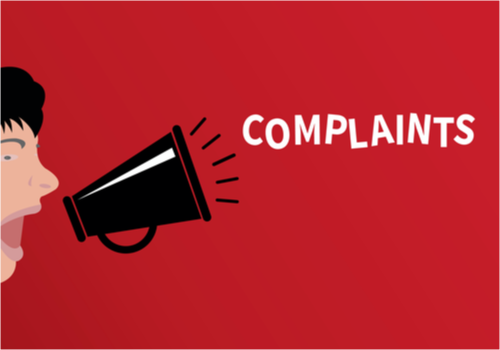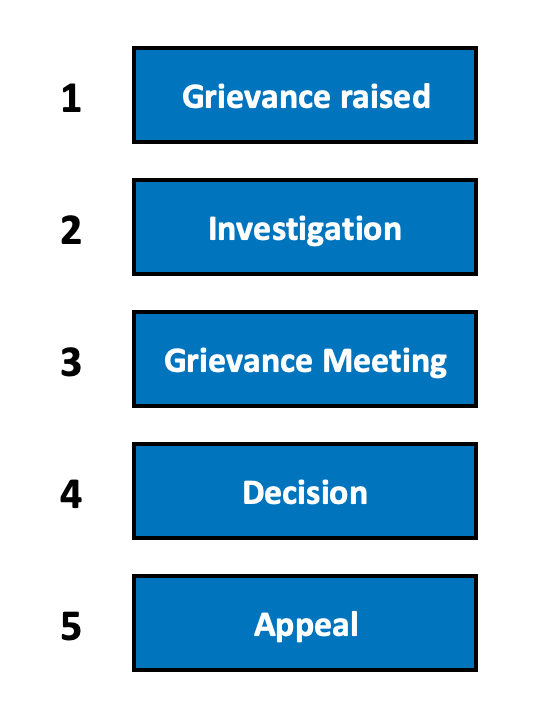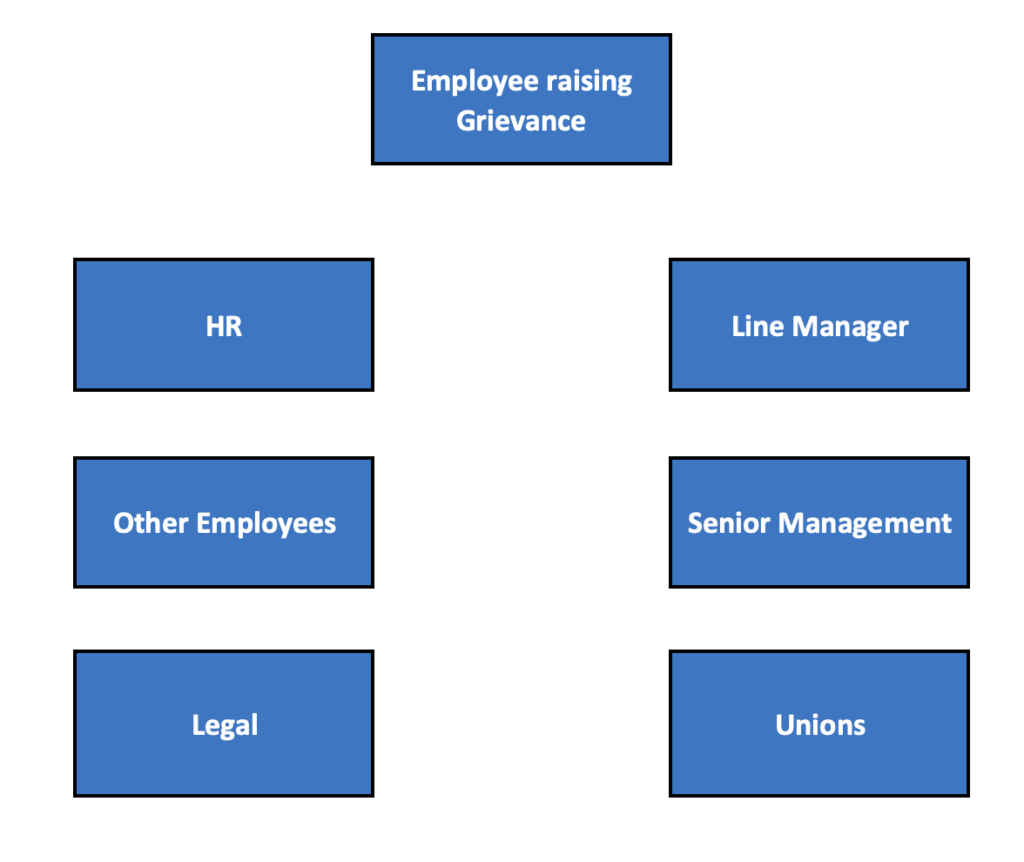
A grievance procedure is a formal, documented process that describes how an employee can raise issues and complaints to their employer.
While every organization’s grievance procedure will be different, most are built on a series of common steps:
1 – The raising of the grievance
2 – Investigation
3 – A Grievance meeting between the employee raising the grievance and representatives of the organization
4 – The Decision
5 – Appeals process
In today’s article, we’ll be reviewing the grievance process in detail; we’ll be covering:
- What is a grievance
- Why you need a grievance procedure
- What are the five steps of a grievance procedure
- Step 1 – Grievance raised by Employee
- Step 2 – Investigation
- Step 3 – Grievance Meeting
- Step 4 – Decision
- Step 5 – Appeal
- The benefits of having a grievance procedure
- Common problems with the grievance procedure
What is a grievance?
A grievance can be defined as “a cause for complaint (either real or imagined)”
Every organization can have conflicts emerge between the organization and employees.
No one workplace is immune.
Just because a grievance has been raised, it does not legitimize it; it will need to be proved.
Complaints may be due to a number of issues, including:
- Working conditions (i.e. Health & Safety)
- Ethics
- Roles and responsibilities
- Injuries
- Coworkers
- Line Manager
- Harassment
- etc
Certain types of grievances will require more serious legal attention; these may require specific policies and procedures – these include:
- Harassment,
- Discrimination
- Injuries sustained in the workplace
- Bullying
Ensure that you always consider potential legal attributes and requirements when you’re building your process.
Why you need a grievance procedure
The grievance procedure describes those steps that need to be taken when an employee raises a concern or complaint.
By having a documented and effective process that the Employee and the organization can follow in the event of an issue, they can
- Be proactive
- Follow the same standard process that is open to all employees
- Be transparent (by following a documented process, all parties will be aware of what will be happening and why)
- Allow for concerns to be reviewed swiftly
- Reduce the opportunity for further issues such as tribunals.
- Through evidence and documents prove that the grievance was handled in a fair and appropriate way.
As we stated earlier, specific types of grievances (e.g., workplace discrimination) may require specific procedures. So you may have a group of procedures and policies that deal with grievances.
What are the Grievance procedure steps?
Let’s now look at the five-step grievance procedure.

Step 1 – Grievance raised by Employee
During this initial stage, the employee will raise the grievance with another member of the organization – this will typically be
- Their Line Manager
- Their Line manager’s manager
- An appropriate member of the HR team
- Someone with the specific responsibility of the receipt of grievances within the organization
Included within many grievance policies will be the requirement for the employee to ensure that the grievance is formally raised within a specified time period of the issue occurring (i.e., a week).
Grievances may be conveyed into the business in several ways
- Verbally (Initially, grievances are often reported verbally to line managers)
- In Writing
Most policies will state that a formal grievance will have to be reported in writing.
If the event is minor, many policies will provide the line manager the freedom to resolve the issue at a local level (whether to the employee’s satisfaction or not).
Clearly, where the employee feels any discomfort in raising the grievance with their line manager, then alternate provision must be made available.
Raising a formal grievance may involve various stakeholders within the organisation, this can be seen from the graphic below:

Step 2 – Investigation
Depending on the grievance, the investigation phase will examine the issue. This may require
- Dialogue with the employee who has raised the issue
- Interviews with other teammates
- Interviews with stakeholders
- Interviews with management (which are often conducted by the HR team).
- Collating and reviewing documentation or evidence that the issue has taken place.
An investigation is commonly carried out by:
- The line manager
- HR
- A specialist team
- A combination of the above
Evidence collated during the investigation is usually copied and stored as records supporting the outcome. Any interviews are also transcribed and captured to support record-keeping.
The time taken for this stage may depend on several factors, including:
- The severity of the claim
- The complexity of the claim
- The evidence that is available
- The number of staff that require interview
- The ease at which evidence can be collected.
During this phase, there may be regular status updates to the staff member who registered the grievance.
Step 3 – Grievance Meeting
A grievance meeting is commonplace within the process.
This review (which sometimes takes place prior to investigation) reviews the grievance together with any evidence that supports the claim.
This review is typically undertaken with the line manager AND a member of the HR team present.
Records (e.g., minutes/actions) are usually taken to both support the claim and to provide evidence that due process has been followed.
Step 4 – Decision
Once the issue has been reviewed and investigated, the organization will come to a conclusion about the validity of the grievance.
It’s important to remember that each grievance is unique and why there may be other similar issues raised; every grievance should be examined on its own merits.
Once a decision has been made, there may be a requirement to determine a settlement (i.e., a monetary award).
Organizations may have strict policies in place regarding such “payouts” and will require agreement from appropriately authorized members of the HR team (and management where required).
Once the above has been agreed upon by the investigatory team, the outcome will be shared with the employee that raised the grievance.
Step 5 – Appeal
Where the grievance has been rejected (whether fully or partially), there is usually an allowance for the employee to make an appeal against the decision.
The organization’s grievance process will usually describe a review process that follows a separate impartial route from the initial investigatory team. This often includes staff of a higher grade than the initial review team.
This process will typically review
- The grievance itself
- The methods and findings of the original hearing.
Once the appeal has concluded, the employee is advised of the outcome.
Benefits of a grievance process
There are various benefits associated with having a formal documented process; these include:
- It supports an evidence-based process
- All employees sign up to the policy as part of terms and conditions of employment, so there are no arguments over the approach
- The same policy is used for all
- Provides a clear mechanism for governance over claims made
- Clearly describes roles and responsibilities within the process
- It reduces potential legal costs
Common problems with the grievance procedure
As with any process, there are some common pitfalls to look out for; these include:
- Organizations fail to treat all concerns as a grievance, and therefore procedure not followed unilaterally
- Organizations need to tread carefully about what line managers can resolve – what’s minor and what isn’t
- Once the process has started, it can be difficult for it to stop
- Organizations have a blinkered approach and do not have an open mind about what might constitute a grievance.
- Line managers are not always an effective first point to raise grievances with.
- Even if an employee is challenging, it doesn’t mean they’re wrong
- Lack of an open door policy resulting in difficulties for employees to lodge grievances.
Summary
Complaints and issues are not rare, and an effective grievance policy is vital within an organization.
It’s key that
- The employee is aware of the process and how their grievance will be investigated.
- The organization is familiar with the process and how it will be utilized.
Transparency and standardization are key benefits.
Organizations should be aware of common issues and look to develop their process, so these are avoided.
As ever, if you have any questions or comments on the article, you can reach out to us on Twitter (@sanbustrain) or use the comments section below.
This article is part of our Human Resources Guide.